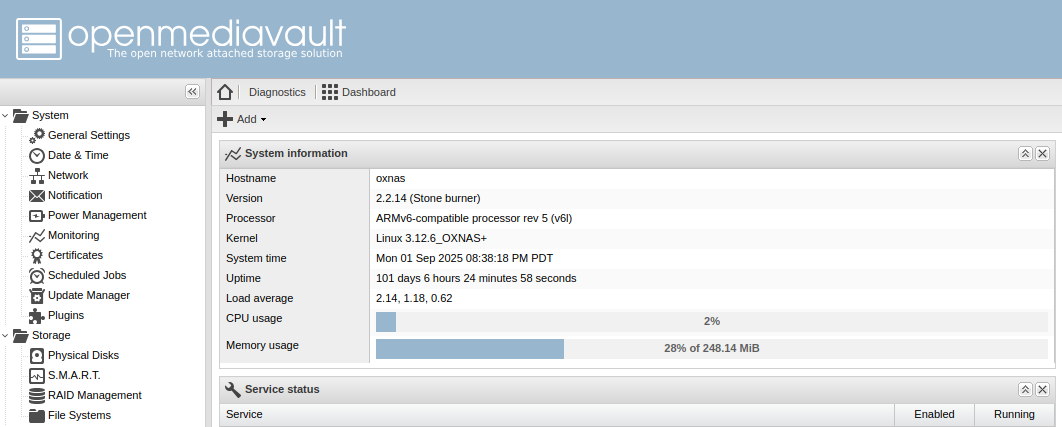Does this count ARMv6 256MB RAM running OpenMediaVault…hmm I have to fix my clock. LOL

Not anymore. My main self-hosting server is an i7 5960x with 32GB of ECC RAM, RTX 4060, 1TB SATA SSD, and 6x6TB 7200RPM drives.
I did used to host some services on like a $5 or $10 a month VPS, and then eventually a $40 a month dedi, though.
What do you use the 4060 for?
Yeah, not here either. I’m now at a point where I keep wanting to replace my last host thats limited to 16GB. All the others - at least the ones I care about RAM on - all support 64GB or more now.
64GB would be a nice amount of memory to have. I’ve been okay with 32GB so far thankfully.
I run a local LLM on my gaming computer thats like a decade old now with an old 1070ti 8GB VRAM card. It does a good job running mistral small 22B at 3t/s which I think is pretty good. But any tech enthusiast into LLMs look at those numbers and probably wonder how I can stand such a slow token speed. I look at their multi card data center racks with 5x 4090s and wonder how the hell they can afford it.
I’m still interested in Self-Hosting but I actually tried getting into self-hosting a year or so ago. I bought a s***** desktop computer from Walmart, and installed window server 2020 on it to try to practice on that.
Thought I could use it to put some bullet points on my resume, and maybe get into self hosting later with next cloud. I ended up not fully following through because I felt like I needed to first buy new editions of the server administration and network infrastructure textbooks I had learned from a decade prior, before I could continue with giving it an FQDN, setting it up as a primary DNS Server, or pointing it at one, and etc.
So it was only accessible on my LAN, because I was afraid of making it a remotely accessible server unless I knew I had good firewall rules, and had set up the primary DNS server correctly, and ultimately just never finished setting it up. The most ever accomplished was getting it working as a file server for personal storage, and creating local accounts with usernames and passwords for both myself and my mom, whom I was living with at the time. It could authenticate remote access through our local Wi-Fi, but I never got further.
Hard to understad why it was difficult. For some reason windows admins are afraid of experimenting, breaking things. Practically I became sys admin by drinking beer and playing with linux, containers, etc.
My home server runs on an old desktop PC, bought at a discounter. But as we have bought several identical ones, we have both parts to upgrade them (RAM!) as well as organ donors for everything else.
7th gen intel, 96GB mismatched ram, 4 used 10TB HDD, one 12 with a broken sata connector that only works because it’s sitting just right in a sled. A couple of 14’s one M.2 and two sataSSD. It’s running Unraid with 2 VM’s (plex and Home Assistant), one of which has corrupted itself 3 times. A 1080 and a 2070.
I can get several streams off it at once, but not while it’s running parity check and it can’t handle 4k transcoding.
It’s not horrible, but I couldn’t do what I do now with less :)
Running a bunch of services here on a i3 PC I built for my wife back in 2010. I’ve since upgraded the RAM to 16GB, added as many hard drives as there are SATA ports on the mobo, re-bedded the heatsink, etc.
It’s pretty much always ran on Debian, but all services are on Docker these days so the base distro doesn’t matter as much as it used to.
I’d like to get a good backup solution going for it so I can actually use it for important data, but realistically I’m probably just going to replace it with a NAS at some point.
A NAS is just a small desktop computer. If you have a motherboard/CPU/ram/Ethernet/case and a lot of SSDs/HDDs you are good to go.
Just don’t bother to buy something marketed as NAS. It’s expensive and less modular than any desktop PC.
Just my opinion.
It’s not absolutely shit, it’s a Thinkpad t440s with an i7 and 8gigs of RAM and a completely broken trackpad that I ordered to use as a PC when my desktop wasn’t working in 2018. Started with a bare server OS then quickly realized the value of virtualization and deployed Proxmox on it in 2019. Have been using it as a modest little server ever since. But I realize it’s now 10 years old. And it might be my server for another 5 years, or more if it can manage it.
In the host OS I tweaked some value to ensure the battery never charges over 80%. And while I don’t know exactly how much electricity it consumes on idle, I believe it’s not too much. Works great for what I want. The most significant issue is some error message that I can’t remember the text of that would pop up, I think related to the NIC. I guess Linux and the NIC in this laptop have/had some kind of mutual misunderstanding.
Yeah, absolutely. Same here, I find used laptops often make GREAT homelab systems, and ones with broken screens/mice/keyboards can be even better since you can get them CHEAP and still fully use them.
I have 4 doing various things including one acting as my “desktop” down in the homelab. But they’re between 4 and 14 years old and do a great job for what they’re used for.
@ripcord @GnuLinuxDude The lifecycle of my laptops:
- years 1-5: I use them.
- years 5-10: my kids use them (generally beating the crap out of them, covering them in boogers/popsicle juice, dropping them, etc).
- years 10-15: low-power selfhosted server which tucks away nicely, and has its own screen so that when something breaks I don’t need to dig up an hdmi cable and monitor.
EDIT: because the OP asks for hardware: my current backup & torrent machine is a 4th gen i3 latitude e7240.
I used to selfhost on a core 2 duo thinkpad R60i. It had a broken fan so I had to hide it into a storage room otherwise it would wake up people from sleep during the night making weird noises. It was pretty damn slow. Even opening proxmox UI in the remotely took time. KrISS feed worked pretty well tho.
I have since upgraded to… well, nothing. The fan is KO now and the laptop won’t boot. It’s a shame because not having access to radicale is making my life more difficult than it should be. I use CalDAV from disroot.org but it would be nice to share a calendar with my family too.
Plex server is running on my old Threadripper 1950X. Thing has been a champ. Due to rebuild it since I’ve got newer hardware to cycle into it but been dragging my heels on it. Not looking forward to it.
Isn’t ryzen not recommended for transcoding? Plus, I’ve read that power efficiency isn’t great. Mostly regarding idle power consumption.
Ryzen is not recommended for transcoding because the Radeon integrated GPU’s encoding accelerator is not as fast as in intel iGPUs. But this does not come into play if you A) have 16 cores and B) don’t even have an integrated GPU.
And about idle power consumption: I don’t think it’s a point of interest if you are using a workstation class computer.
I think it’s a point of a interest for any hw running 24/7 but you do you.
Regarding transcoding, are you saying you’re not even doing it? If you are, doing it with your cpu is far more inefficient than using a gpu. But again, different strokes I guess.
Dunno whether they are transcoding or not nor why they have such a bizarre setup. But I would hope 16C/32T CPU from 2017 could handle software transcoding. Also peak power consumption while playing a movie does not really matter compared to idle power consumption. What matters more is that the motherboard is probably packed with pcie slots that consume a lot of power. But to OP it probably does not matter if they use a threadripper.
My NAS is on an embedded Xeon that at this point is close to a decade old and one of my proxmox boxes is on an Intel 6500t. I’m not really running anything on any really low spec machines anymore, though earlyish in the pandemic I was running boinc with the Open Pandemics project on 4 raspberry pis.
My first @home server was an old defective iMac G3 but it did the job (and then died for good) A while back, I got a RP3 and then a small thin client with some small AMD CPU. They (barely) got the job done.
I replaced them with an HP EliteDesk G2 micro with a i5-6500T. I don’t know what to do with the extra power.
What are you running on it?
Prosody (XMPP server), a git instance, a searXNG instance, Tandoor (recipe manager), Next Cloud, Syncthing for my phone and my partner’s (one could say Next Cloud should be enough but I use it for different purposes), and a few other stuff.
It doesn’t even use an eight of its total RAM and I’ve never seen the CPU go past 20℅. But it uses a lot less power than the thin client it replaced so not a bad investment, especially considering its price.
How do you like searxng and have you considered hosting openstreetmaps?
I started my self hosting journey on a Dell all-in-one PC with 4 GB RAM, 500 GB hard drive, and Intel Pentium, running Proxmox, Nextcloud, and I think Home Assistant. I upgraded it eventually, now I’m on a build with Ryzen 3600, 32 GB RAM, 2 TB SSD, and 4x4 TB HDD
My first server was a single-core Pentium - maybe even 486 - desktop I got from university surplus. That started a train of upgrading my server to the old desktop every 5-or-so years, which meant the server was typically 5-10 years old. The last system was pretty power-hungry, though, so the latest upgrade was an N100/16 GB/120 GB system SSD.
I have hopes that the N100 will last 10 years, but I’m at the point where it wouldn’t be awful to add a low-cost, low-power computer to my tech upgrade cycle. Old hardware is definitely a great way to start a self-hosting journey.
Maybe a more reasonable question: Is there anyone here self-hosting on non-shit hardware? 😅
2 GB RAM rasp pi 4 :))
Rehabilitated HP z440 workstation, checking in! Popped in a used $20 e5-2620v4 xeon CPU and 64gb of RAM and it sails for my use cases. TrueNAS as the base OS and a TalOS k8’s cluster in a VM to handle apps. Old but gold.
10400F running my NAS/Plex server and raspberry pi 5 running PiHole
I have pi-hole on my Mac mini using docker but I stopped using it, it makes some things super laggy to load
Interesting, I haven’t had any issues with things loading with mine, maybe it’s your adlists causing issues? Try disabling some, there might be false positives in there giving you issues
I tried the default ones
You can pry my gen8 hp microserver from my cold, dead hands.
Me using Threadripper 7960X and R5 6600H for my servers: 🤭
I’m happy with my little N100
Enterprise level hardware costs a lot, is noisy and needs a dedicated server room, old laptops cost nothing.
I got a 1U rack server for free from a local business that was upgrading their entire fleet. Would’ve been e-waste otherwise, so they were happy to dump it off on me. I was excited to experiment with it.
Until I got it home and found out it was as loud as a vacuum cleaner with all those fans. Oh, god no…
I was living with my parents at the time, and they had a basement I could stick it in where its noise pollution was minimal. I mounted it up to a LackRack.
Since moving out to a 1 bedroom apartment, I haven’t booted it. It’s just a 70 pound coffee table now. :/









